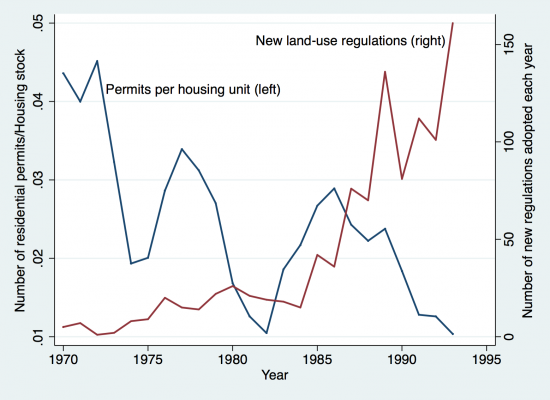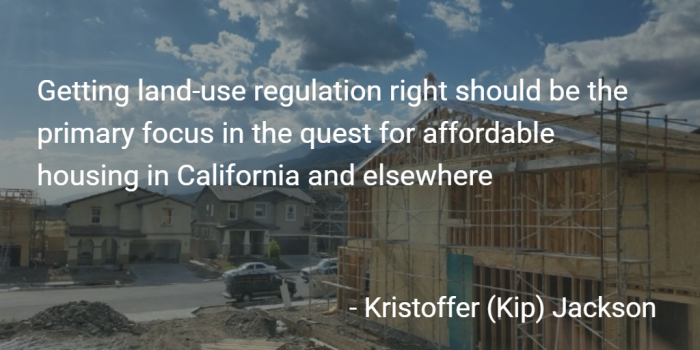 The state of California has some of the most expensive housing in the country. In new research, Kristoffer (Kip) Jackson investigates why homes in the Golden State have come to cost so much. He finds that it’s down to how land use is regulated; each new land-use regulation reduces a Californian city’s housing supply by 0.2 percent per year. In addition, regulation has a spillover effect, with neighboring cities increasing their own regulations in response to those of others in order to avoid taking on all of a region’s new development.
The state of California has some of the most expensive housing in the country. In new research, Kristoffer (Kip) Jackson investigates why homes in the Golden State have come to cost so much. He finds that it’s down to how land use is regulated; each new land-use regulation reduces a Californian city’s housing supply by 0.2 percent per year. In addition, regulation has a spillover effect, with neighboring cities increasing their own regulations in response to those of others in order to avoid taking on all of a region’s new development.
California is home to some of the most expensive housing in the country. In some California cities, the average four-bedroom, two-bathroom home would set you back over $2 million, while a similar home would cost less than $100,000 in many other US cities. For anyone who has enjoyed California’s temperate-Mediterranean climate or spent time on some of its beautiful beaches, it is not surprising that such amenities come at a cost. While these demand factors certainly affect housing prices, supply factors—such as the number of homes available for purchase—are equally important in understanding why housing is so expensive in California.
In the absence of physical or other impediments, rising home prices signal profit opportunities to developers, who, in order to exploit these opportunities, respond by building new homes. To the extent that new housing can keep pace with rising demand, we would not expect prices to remain at such high levels as they have in California. However, to the detriment of many working-class families in the Golden State, there are considerable barriers that prevent developers from providing the amount of construction necessary to make housing affordable there. While geographic characteristics (like mountains and the coast) certainly play a role in restricting development in some California communities, local regulatory regimes create an equally difficult obstacle for developers to overcome.
California cities’ use of land-use regulation (including various zoning rules, residential density restrictions, and limitations on growth) increased precipitously from the mid-1980s to the early 1990s (see figure below). In a state known for making extensive use of voter initiatives, this increasing level of regulation was the result of rising anti-growth sentiment following periods of rapid population growth. Unsurprisingly, the most highly regulated communities back then—in the southern coastal region and in the San Francisco Bay area—still top the list today.
Figure 1 – Residential permitting rate and additional regulations adopted over time, California

Source: Land-use regulation data from survey responses of local land-use authorities in 402 California cities. Permit and housing stock data from the California Housing Foundation’s Construction Industry Review Board and US Census Bureau, respectively.
Comparing the rate of construction in cities that implement more land-use regulations to the rate in cities that implement less of it, I find that each additional regulation reduces a city’s housing supply by about 0.2 percent per year. The average California city used in my analysis has a population of roughly 55,140 with 21,740 homes. For such a city, adding a new land-use regulation reduces the housing stock by about 40 units per year. Reductions in a city’s housing stock are the result of significant declines in the rate of new-home building. The number of new homes built each year is reduced by an average of 4 percent per restriction. These reductions in new construction (and the overall housing stock) come through fewer single- and multifamily housing units, but the effect on the latter is much stronger, with an average of 6 percent fewer permits issued per regulation.
Taken as a whole, regulation reduces residential development. However, the degree to which individual regulations affect development varies, and some “anti-growth” policies actually increase development (at least in the short run). The most obvious way in which land-use regulation might reduce construction is by explicitly limiting the amount of new development that can occur. One of the most restrictive regulations, caps on residential building permits, reduce construction of single-family homes by roughly 30 percent, while restrictions on the number of new lots created for a subdivision cause multifamily construction to fall by 45 percent. Imposing restrictions on the form of new homes also affects the rate at which they are built: height restrictions (in the form of limitations to the floor-area ratio) can reduce single-family construction by as much as 23 percent. Arguably the most significant regulatory burden borne by local housing developers is bureaucratic/political uncertainty, particularly when the zoning code is complex and subject to voter approval.
While commonly touted as an effective remedy to urban sprawl, I find that urban growth boundaries (also known as “green belts”) actually increase the construction of single-family homes. Urban growth boundaries have been shown to increase the value of new homes, so it is not surprising that development would accelerate until abutting on the established boundary.

In addition to the direct effects of regulation on a city’s housing supply just described, local regulatory regimes also affect housing market outcomes in neighboring communities through regulatory spillover. In California, city and unincorporated county governments are given a significant amount of autonomy in how they manage land-use, which leads to regulatory competition among nearby cities. Rather than the kind of tax-rate “race to the bottom” that often occurs when localities compete for businesses or residents, this form of competition leads to increasing levels of regulation as residents and city officials attempt to stifle growth in their communities. Although land-use regulation is generally implemented at the city (or county) level, growth is a regional phenomenon. So, like a tube of toothpaste, when regulatory pressure is put on development in one city, it typically spills over into less-regulated neighboring cities. Thus, in order to avoid taking on all of the region’s new development, cities tend to adopt similar regulatory patterns as their neighbors, both in terms of the level of regulatory stringency and the actual policies adopted.
Draconian land-use regulations impede residential development by making it harder for developers to respond to rising demand—particularly for multifamily dwellings. If housing is to be made more accessible in California and other expensive parts of the country, barriers to development must be overcome. Geographic constraints like the coast are difficult to overcome, but regulatory barriers are, at least in theory, of a more pliable nature. California Governor Jerry Brown’s recent attempts to ease the state’s regulatory impact are movements in the right direction, but more must be done to offset the effects of years of stringent local restrictions. Getting land-use regulation right should be the primary focus in the quest for affordable housing in California and elsewhere.
Featured image credit: Mikirk (Flickr, CC-BY-NC-SA-2.0)
This article is based on the paper, ‘Do Land Use Regulations Stifle Residential Development? Evidence from California Cities’ in the Journal of Urban Economics.
Please read our comments policy before commenting.
Note: This article gives the views of the author, and not the position of USAPP – American Politics and Policy, nor the London School of Economics, the Office of the Comptroller of the Currency, or the US Department of Treasury.
Shortened URL for this post: http://bit.ly/29uFUsJ
_________________________________
 Kristoffer (Kip) Jackson – Office of the Comptroller of the Currency
Kristoffer (Kip) Jackson – Office of the Comptroller of the Currency
Kip Jackson is a Financial Economist in the Economics Department at the Office of the Comptroller of the Currency. His research focuses primarily on measuring land-use regulation and estimating its effects on housing markets and the demographic make-up of cities. Dr. Jackson holds a Ph.D. from the University of California-Irvine and a B.S. from Utah State University.







“In addition, regulation has a spillover effect, with neighboring cities increasing their own regulations in response to those of others in order to avoid taking on all of a region’s new development.” is a quote that’s patently false, beyond logical comprehension. Article is disinformation propaganda.
“is a quote that’s patently false, beyond logical comprehension.”
Seems like that quote explains it pretty well. When I lived in Thousand Oaks (1992-1996), the city had either just finished, or was in the process of implementing their small-growth regulations and plans. One of the major issues was that increased demand outstripping supply of housing in the San Fernando Valley (again, because of regulation), that large numbers of new developments and residents from the Valley would disrupt the ‘feel’ as well as the housing prices of TO. The talking point was literally “Protect TO from becoming the San Fernando Valley”.
Everything is California is over-regulated. There is a reason so many companies are leaving for Arizona and Texas.
Cary Michael Cox
In addition, regulation has a spillover effect, with neighboring cities increasing their own regulations in response to those of others in order to avoid taking on all of a region’s new development.” is a quote that’s patently false, beyond logical comprehension. Article is disinformation propaganda.
The real truth is because California is liberal and they are heavily in debt. 8/16 years California has ran a deficit. They have an astronomical government budget because of their entitlements and to pay for that prices have to go up somewhere.
If you understand economics you’d realize that as a whole this country spends 2.7 Trillion dollars EACH YEAR to pay for government employees (both federal, state, and local). Where does that 2.7 Trillion come from? It comes from the tax payer because the tax payer is the only one who makes money.
Good article, makes perfectly sense. Normally, the construction of new homes follows the establishment and growth of succesfull businesses, which require a city to invest in addtional homes to keep up with the economical development and accompanying expanding need for housing.